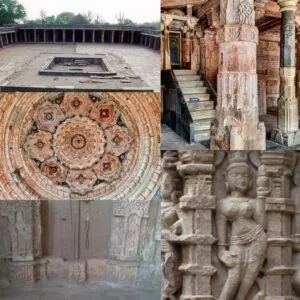Bhojshala-Kamal Maula Mosque complex in Madhya Pradesh’s Dhar, where the Archaeological Survey of India (ASI) conducted a scientific survey, revealed temple remnants and Hindu inscriptions. The ASI concluded that materials from a pre-existing temple were utilized in constructing the structure.
About the Bhojshala Temple-Kamal Maula Mosque Complex:
- The Bhojshala Temple-Kamal Maula Mosque complex was originally constructed as a temple dedicated to the goddess Sarasvati by Parawara King Bhoja in the 11th century AD.
- The mosque was later built using structural elements from this temple.
- Some slabs within the monument still bear inscriptions in Sanskrit and Prakrit.
- King Bhoja, a renowned patron of art and literature, is credited with founding a school, now referred to as Bhojashala.
- According to an agreement with the Archaeological Survey of India (ASI), Hindus conduct puja in the temple every Tuesday, while Muslims offer Namaz every Friday.
Who built the Bhojshala?
- According to the official website of Dhar district, Raja Bhoj, a prominent ruler of the Parmar dynasty (1000-1055 AD), built a college in Dhar, which became known as Bhojshala.
- This site, initially a Saraswati temple, was later transformed into a mosque by Muslim rulers.
- Despite this, remnants of the original temple are still visible within the Kamal Maula Mosque.
Who constructed the mosque in Bhojshala?
- Historians state that the initial attack on Dhar Bhojshala was carried out by Alauddin Khilji, leading to its destruction in 1305.
- Later, in 1401, Dilawar Khan Gauri constructed a mosque on a section of Bhojshala.
- Subsequently, in 1514, Mahmood Shah Khilji also built a mosque in another part of Bhojshala.
Historical timeline of Bhojshala:
- 1305: Alauddin Khilji destroyed Bhojshala.
- 1401: Dilawar Khan Gauri built a mosque in a part of Bhojshala.
- 1514: Mahmood Shah Khilji also built a mosque in another part of Bhojshala.
- 1875: The statue of Mata Saraswati was found during excavation.
- 1875: British Major Kinkaid took the statue to London.
- Present: The statue is in the Museum of London.
Dispute:
- The main controversy centres on the site’s original status as a temple. The petitioner references an ASI report alleging that the original Bhojshala and Vagdevi temples were demolished to construct a mosque.
- A survey has been requested to uncover the true history of the site.
- One respondent argued against the suit’s validity based on the principle of res judicata, pointing out that a similar petition was dismissed by the High Court’s Principal Bench in 2003.
High Court’s Order:
- The court noted that the exact nature of the temple remains unclear and must be determined.
- All parties agreed on the necessity to clarify the monument’s status, a task assigned to the ASI under the Monument Act, 1958.
- The court instructed the ASI to conduct a thorough scientific survey, excavation, and investigation using advanced techniques like GPR-GPS and carbon dating.
- This investigation is to include not only the site itself but also a 50-meter surrounding area.
Methods Adopted by the ASI for Excavation
Invasive Methods:
- Excavation is the most invasive archaeological technique, involving digging based on stratigraphic principles to collect information about the past, though this process simultaneously destroys the site.
- Archaeologists use stratigraphy to systematically remove layers in reverse order, helping them understand the chronological formation of the archaeological record.
Non-Invasive Methods:
- Non-invasive methods are employed when investigations are conducted within built structures where excavation is not allowed.
- These methods include:
- Active Methods:
- General Approach: These methods introduce energy into the ground and measure the response to estimate the material properties of the ground, such as density, electrical resistance, and wave velocity.
- Seismic Techniques: Utilize shock waves to study subsurface structures.
- Electromagnetic Methods: Measure the response of the ground after injecting electromagnetic energy.
Passive Methods:
- General Approach: These methods measure existing physical properties of the ground.
- Magnetometry: Detects magnetic anomalies caused by buried structures.
- Gravity Surveying: Measures variations in gravitational force due to subsurface features.
- Ground-Penetrating Radar (GPR): ASI uses GPR to create 3-D models of buried archaeological features.
- GPR works by sending a short radar impulse from a surface antenna and recording the time and magnitude of the return signals from the subsoil.
- The radar beam spreads like a cone, causing reflections that may not directly correspond to the physical dimensions of the objects, sometimes creating false images.
- Carbon Dating: This technique determines the age of organic material by measuring its carbon content (C-14).
Recent findings by the ASI in Bhojshala-Kamal Maula Mosque complex
- Recent findings by the ASI, based on a three-month scientific survey using technologies such as ground-penetrating radar and analysis of archaeological remains, suggest that the pre-existing structure dates back to the Paramara dynasty period.
- The art and architecture of the pillars and pilasters indicate they were originally part of a temple, with deities and human figures that were mutilated for reuse in the existing structure.
- The survey revealed that the current structure features long colonnades in all four directions with 106 pillars and 82 pilasters, adorned with images of Hindu deities like Ganesha, Brahma, Narasimha, Bhairava, and various human and animal figures.
- Many of these images have been defaced or chiselled out, as such representations are not permitted in mosques.
- Inscriptions in Sanskrit and Prakrit, dating back to the 13th century CE, were found at the site.
- One inscription references King Naravarman of the Paramara dynasty.
- Additionally, an inscription on the gateway to Abdullah Shah Changal’s tomb at Dhar mentions the violent conversion of the temple into a mosque by Mahmud Shah of the Khilji dynasty in 1455 CE.
Challenges in Archaeological Survey Methods:
- Similar physical properties across different materials can produce identical responses, resulting in difficulties in identifying specific targets.
- The gathered data is often limited and prone to measurement errors, complicating the accurate estimation of spatial property distribution.
- Archaeological structures frequently consist of heterogeneous materials with intricate geometries, making data interpretation arduous.
- Geophysical tools may struggle to accurately reconstruct images of targets, particularly in complex environments.
- Emotional and political factors can impact interpretations and decisions, especially in sensitive cases like disputes over religious sites.
About the Archaeological Survey of India (ASI)
- The Archaeological Survey of India (ASI), operating under the Ministry of Culture, is the leading body responsible for archaeological research and the preservation of the nation’s cultural heritage.
- It oversees the administration of over 3,650 ancient monuments, archaeological sites, and remains deemed of national significance.
- ASI’s responsibilities include conducting surveys of antiquarian remains, exploring and excavating archaeological sites, and the conservation and maintenance of protected monuments.
- Established in 1861 by Alexander Cunningham, the first Director-General of ASI, Cunningham is also recognized as the “Father of Indian Archaeology.”
Explore our courses: https://apnipathshala.com/courses/
Explore Our test Series: https://tests.apnipathshala.com/










